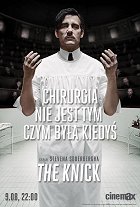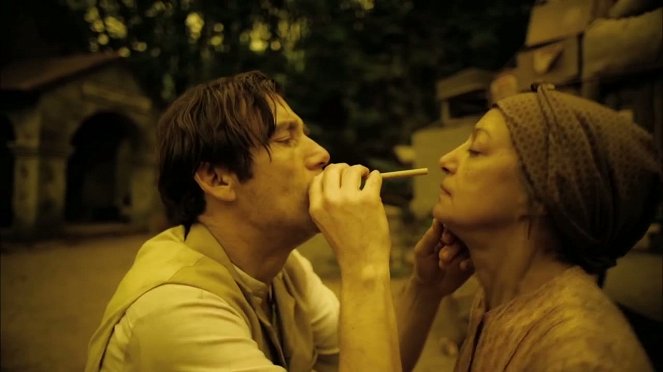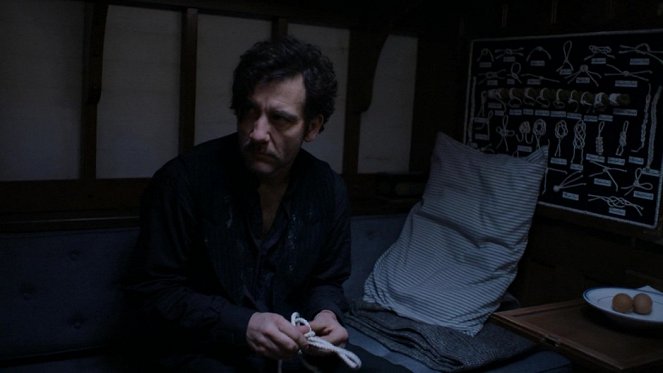Regie:
Steven SoderberghKamera:
Steven SoderberghMusik:
Cliff MartinezBesetzung:
Clive Owen, Eve Hewson, André Holland, Eric Johnson, Juliet Rylance, Chris Sullivan, Cara Seymour, Zuzanna Szadkowski, Lucas Papaelias, Suzanne Savoy (mehr)Streaming (4)
Staffel(2) / Folgen(20)
Inhalte(1)
New York im Jahre 1900. Im Knickerbocker Hospital schaffen Chirurgen, Ärzte und sämtliche Mitarbeiter ganz neue Standards in Sachen medizinischer Versorgung – und dies in einer Zeit, in der die Sterblichkeitsrate bei Patienten besonders hoch ist und Antibiotika noch nicht existieren. An vorderster Front: Dr. John W. Thackery (Clive Owen). (Verleiher-Text)
(mehr)Videos (53)
Kritiken (8)
Knochen, Gewebe und Blut der Moderne, geboren aus Wahnsinn und Chaos. Eine Tadellose Regie, brillant unterlegt mit Martinez' kühlem und modernem Ambiente-Backing. Ein kompromissloser Schnitt, wenn das so weitergeht, wird der Knick der eindeutige Gewinner der Saison sein. [Pilot 95%]
()
It is the ultimate series and for me personally perhaps the most intense experience I have ever seen from Steven Soderbergh. It was raw, brutal, realistic and with acting performances so amazing that it should be receiving awards for at least two more years. Clive Owen versus Andre Holland show such a perfect war of doctors that you simply have to love both of them. However, be careful with this series, more delicate viewers might not be comfortable with some scenes. Even I had troubles sometimes. There is such natural depiction of surgeries that you sometimes get to see things you don’t necessarily need to. For the great premise I cannot rate it any other way than with five stars. I hope it can keep up for as long as possible.
()
A medical series after the end of which you feel the need to wash off the drying blood and scrape the residue of a large intestine and placenta from under your fingernails. Soderbergh slowly and thoroughly draws us into a vortex of systematised madness and without regard for how many viewers will abandon the show after the first five minutes, when we’ll be doing cocaine with a racist misogynist, riding down a New York street where a black horse gasps in pain, and bearing witness to the death of a mother and her newborn child. ___ In addition to the music and natural (i.e. gloomy) lighting, Soderbergh’s cinematography is particularly helpful in inducing a feeling of nausea and the impression of a time and place where death is always just a step away and where you definitely would not want to end up with any illness more serious than a cold. The camerawork becomes more agitated along with the characters and transitions from clearly arranged, carefully composed shots giving the butchery on the operating table a hint of being civilised to immediate fly-on-the-wall observation and visceral, manually filmed close-ups. The fluidity of the narrative and the impression of a constant flow of events are aided by the “relay” observation of the characters, when the camera’s attention shifts from one actor and smoothly continues with another actor in the same shot. ___ The hospital is a complex organism whose problem-free operation requires the coordination of several notional tentacles and the taming of the egos for which the characters fight first and foremost rather than for their patient’s lives. While Thackery chooses cocaine to take the edge off and Barrow visits brothels, Edwards compensates for his inability to publicly fulfil his masculine role by engaging in self-destructive brawls like the protagonists of Fight Club. Most of the characters are connected by a theme that runs in various forms through Soderbergh’s filmography – the inability or impossibility to fit into the world in which they live and the associated emotional emptiness and feelings of alienation and loneliness. Thanks to the diversity of the individual characters and the conflicts that arise between them (while Thackery directly challenges God), Soderbergh’s dissection of a morally corrupt society succeeds in covering a broad range of issues, such as racial segregation, social stratification, the intertwining of class and racial tensions, corruption, migration, drugs and the church. With its effort to maintain a balanced distribution of attention, The Knick is akin to the more documentary-style untangling of complex webs known from the works of David Simon (The Wire, Treme). ___ The fourth episode, in which the central characters go hard at each other in games started previously, is comparably as dynamic as the pilot. However, not as much happens or as quickly, and what gives the episode its dynamism are primarily the constant changes in perspective, a Soderbergh trademark that superbly utilises varying depth of field. None of the many conflicting perspectives is privileged, which corresponds to the creators’ effort not to judge anyone and to show – with a clinical view and without embellishment or prejudice – that scientific and technical development was bought at the cost of devaluation of interpersonal relationships into mere business a century ago (techno-fetishistic details of every imaginable patent are increasingly available). 90%
()
(weniger)
(mehr)
A hospital at the turn of the twentieth century in an original series where its biggest strength is also its biggest weakness (well, more like just a weakness) because when Soderbergh took all of the clichés from series set in a medical environment and very consistently, bleakly, uncompromisingly and almost cynically turned them inside out, the moment of surprise is lost because whatever motive or storyline comes up, if you turn it one hundred and eighty degrees against what you would usually expect, and you know exactly what’s going to happen. In any case, this criticism fades in the light of everything else; the production design and the accent on disturbing period details to start with (definitely nothing for a nostalgic romantic “those were the times") and to finish with the acting performance (I wonder if Thackery was inspired by W.S. Halsted). Looking at this purely in terms of filmmaking, this is at the very head of the (not only) series pack. If nothing else, I should mention the operations. Soderbergh presents this crude butchery so realistically, with no embellishments, intensively and originally (the rhythm of the shots!), for my life, I can’t remember when I had to turn my eyes away so often due to feeling squeamish; and it’s not just to do with the explicitness of the shots, but also thanks to the fact that it’s all presented so strictly pragmatically that it’s far more effective than if they were operating with emotional blackmail alone. And a special thanks traditionally belongs to Martinez whose seemingly inappropriate and out of place background music does a whole lot for the series.
()
Soderbergh's redemption from the prison called Hollywood and a clear argument for those who claim that TV production in recent years is more interesting and progressive than film. I am no longer surprised by Soderbergh's words that he has finally found the creative freedom in contemporary television that was so lacking in big-studio film production.
()



Werbung